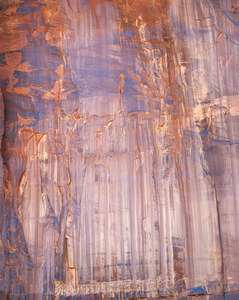
Wall, Monument Valley, Arizona
This is the fifth in a series of walls I photographed in the late morning one clear day at Monument Valley and probably the most expressive bit of stone I have ever seen. There are four separate patterns evident in the 400 to 500 vertical feet of rock: one is the desert varnish, here seen reflecting the blue of the sky; another is the vertical striping, or tapestry, made by lichen growth wherever water pours over the wall during storms; yet another is the pattern of fractures which define the shape of the surface itself; and the fourth is the pattern of the amazing strata of the sandstone, which if you look closely can be seen to exhibit the property unique to aeolian formations. Groups of layers often abruptly end at other groups of layers oriented at a very different angle, with no evidence or possibility of faulting or other disruption of the original pattern. Most sandstones are formed by the deposition of successive layers over broad areas and so can never resemble this de Chelly sandstone in cross section, no matter how they are broken or bent. But this formation consists of 250-million-year-old, fossilized sand dunes! Contrary to Hollywood's portrayals, sand dunes are actually rather rare and generally only occupy a tiny fraction of the total land area in deserts. There were long periods, however, during which the prehistoric Southwest was very broadly covered with dunes associated with an ancient river delta.

